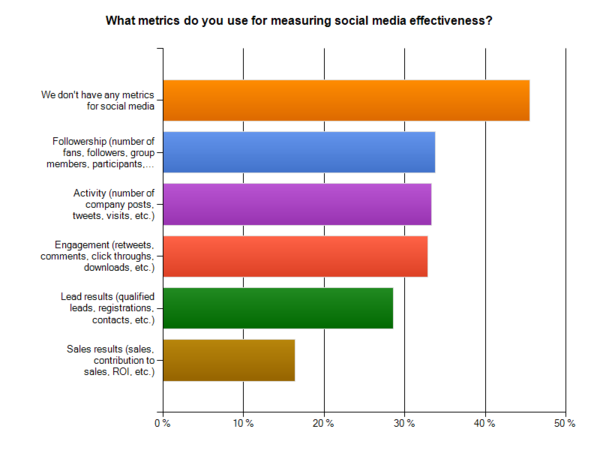
“How do I measure social media return on investment?” This is the #1 question over 3,300 marketers ask Social Media Examiner every year in the Annual Social Media Marketing Report.
Pictures, however, tell a different story. The first one below from Google Trends measures the year-to-year change in search volume for the phrase, “social media marketing,” which is increasing significantly.

But the second, from econsultancy, says what isn’t increasing is marketers measuring Social Media ROI, even though they say it’s their #1 priority. Hmm…

According to Marketing Sherpa, the top reasons that marketers use to explain this behavior are:
- Lack of knowledgeable staff
- Inability to measure ROI
- Management resistance
- Technical complexity
To help, here are 8 steps to demystify Social Media ROI.
1. BEGIN WITH THE END IN MIND: Since it’s called return on investment, begin by identifying the return you want at the end. Define and quantify your expectations. For example, do you want to: 1) Increase sales by 50%, 2) shorten the purchase cycle by 1/3, 3) double leads, 4) increase conversion by 40% or 5) decrease customer complaints by 75%. Be as specific you can be at the start; it increases the success you have measuring ROI at the end.
2. IDENTIFY WHO TO ATTRACT: Social media is one of the best channels for building 1-to-1 relationships. Take the time to identify who you want to attract and find the social networks where they spend their time. There are are great tools to help you. For blogs, there’s Technorati and Alltop. For Facebook, there’s Your Openbook and Booshaka. For Twitter, there’s Twitter Search and Kurrently. Just go to the search box in any of them and type in the product or service you offer. In fact, put the words, “buy” or “need” in front of it and you’re one step closer to a 1-to-1 business relationship.
3. FIND OUT HOW THEY FIND YOU: As you succeed with who you want to attract, your audience is going to want to find out more about you. The first place they are going to go is your website which should have an analytics tool like Google Analytics. Look at your “Traffic Sources:” then, look at “Referral Sources” to see which social networks provide the greatest number of visitors. Assess if this is in line with the social networks where you spend your time and resources.
4. ESTABLISH YOUR VALUE EXCHANGE: Companies ask that you “Like” them on Facebook. Ok. Now what? This chart below tells you consumers are motivated to “Like” you if you show them some “Love,” first. It also tells you, if you take this step, they show their support for your brand in return. If you need some help showing some promotional “Love,” Wildfire offers some great social media apps that are effective, affordable and make the value exchange easier for you to execute.
6. PICK METRICS YOU’LL TAKE ACTION ON: There’s is no shortage of measurements in social media and monitoring them has turned into big business. I’m a believer that less is more. “Likes” and “Followers” are worth measuring if you’re prepared to take action when they go up or down. If more marketers flipped the chart below from HubSpot upside down and used it as a guideline to pick the metrics they should track, they’d be well on their way to an effective social media scorecard for ROI.
8. BE CONSUMER CENTRIC: Even though we should all be concerned about the numbers and revenue, social media is a human media channel and never lose focus on delighting and being genuine with consumers every time you are in contact with them. If you do, you’ll find the numbers start to take care of themselves.
Do these 8 steps demystify Social Media ROI for you?







[…] Rob Petersen de BarnRaisers nos indica que hay una clara tendencia hacia el interés de los marketers en relación a este […]
[…] Rob Petersen de BarnRaisers nos indica que hay una clara tendencia hacia el interés de los marketers en relación a este […]
[…] Rob Petersen of BarnRaisers points out that there is a clear trend towards the interest of marketers in relation to this area, nevertheless as can see in the following graphics by eConsultancy, more than 40% of businesses with a presence in social media are completely unaware of its ROI, and that is one of their most important priorities. […]